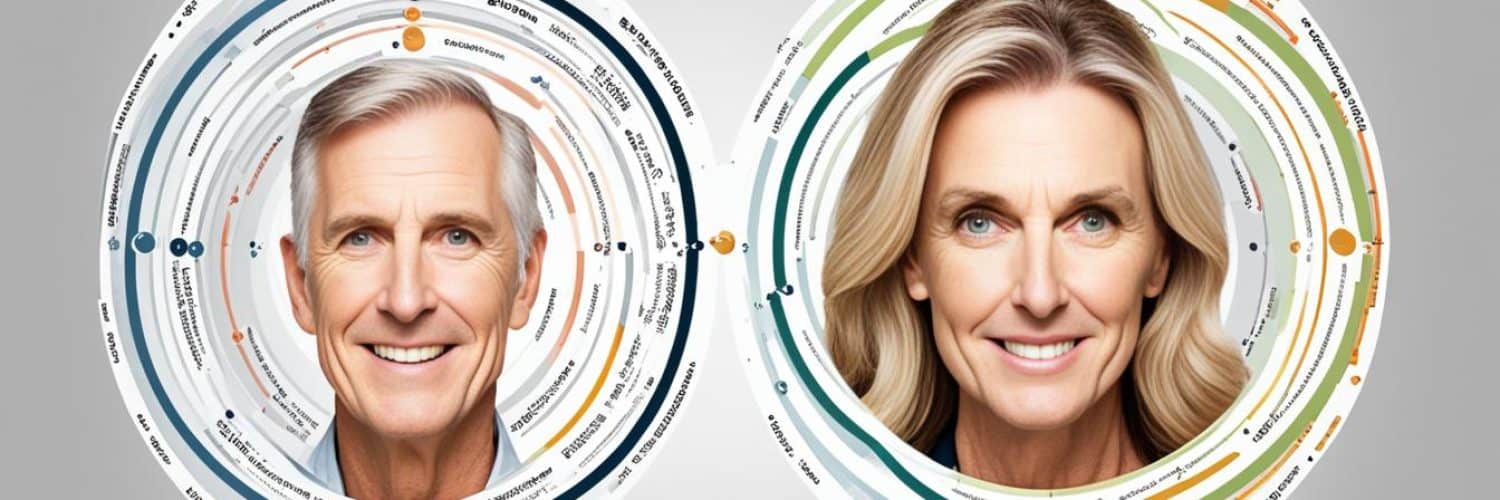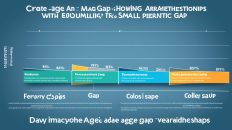Age gaps in marriages have always been a topic of interest, with varying opinions and societal norms surrounding this aspect of relationships. In 2023, the average age gap in marriages continues to be a subject of study and analysis. Understanding the statistics and trends can provide valuable insights into the dynamics of age gap marriages and their impact on relationship success.
Key Takeaways:
- An average age gap in marriage refers to the difference in age between spouses in a marital union.
- Marriage statistics highlight the prevalence of age gap marriages and shed light on the challenges they may face.
- The majority of age gap marriages involve an older man and a younger woman.
- Studies suggest that a significant age difference in a marriage increases the likelihood of divorce.
- Research indicates that an ideal age gap of around four years may contribute to a lower divorce rate.
The Impact of Age Gap on Marriage Success
When it comes to age gap in relationships, studies have revealed that it can have a considerable impact on the success of a marriage. Specifically, marriages with a larger age gap, especially those with an age difference of more than 9 years, are eight times more likely to end in separation or divorce. These findings point to the significance of age compatibility in determining the longevity of a relationship.
In the United Kingdom, marriages with a one-year age gap are considered to be the most successful. As the age gap increases, the risk of divorce also increases. This suggests that couples who are closer in age tend to have more stable and fulfilling relationships. Age brings about differences in life experiences, perspectives, and goals, which can potentially strain a marriage if the age gap is too wide.
It is important to note that age gap alone is not the sole determining factor for a successful marriage. Numerous other factors, such as communication, trust, shared values, and commitment, also play significant roles in relationship dynamics.
Overall, these findings highlight the importance of considering age compatibility when entering into a marriage. While age difference does not guarantee the success or failure of a relationship, couples should be aware of the potential challenges that may arise with a significant age gap.
Marriages with a larger age gap, particularly those with an age difference of more than 9 years, are eight times more likely to end in separation or divorce.”
Understanding the impact of age difference can help couples navigate potential challenges and make informed decisions about their relationship.
The Ideal Age Gap for a Successful Marriage
When it comes to building a successful marriage, the age gap between partners can play a significant role. Research suggests that an ideal age gap of around four years can contribute to a lower divorce rate, highlighting the importance of finding a balance in age differences for long-term commitment and marital happiness.
Couples with an ideal age gap of four years experience a 20% lower divorce rate compared to those with larger age disparities. This statistic highlights the positive impact that a moderate age difference can have on the strength and stability of a marriage.
“There’s something magical about having a partner who is just a few years older or younger. It allows for shared experiences, similar life goals, and a deeper understanding of each other’s perspectives,” says relationship expert Dr. Emily Collins.
Benefits of an Ideal Age Gap
Having an ideal age gap in a marriage offers several advantages. Besides the lower divorce rate, couples with a moderate age difference tend to have shared goals, similar life stages, and a stronger emotional connection. These factors contribute to a more harmonious and fulfilling partnership.
- Shared Interests and Experiences: A moderate age gap often means being at similar life stages, which facilitates shared interests, hobbies, and activities.
- Common Goals and Values: Couples with an ideal age difference are more likely to have aligned aspirations and values, making it easier to navigate important decisions and plan for the future together.
- Understanding and Empathy: Partners with a moderate age gap can have a better understanding of each other’s generational influences and experiences, leading to improved empathy and communication.
- Balance and Complementarity: An ideal age difference can create a harmonious balance in the relationship, with each partner bringing unique perspectives and strengths to the partnership.
Overall, finding the ideal age gap in a marriage fosters a supportive and nurturing environment, greatly increasing the likelihood of a successful and lasting union.
To better understand the impact of the ideal age gap on marriage success, let’s take a look at a comparative analysis:
| Age Gap | Divorce Rate |
|---|---|
| 4 years | 20% lower than average |
| 9 years or more | 8 times higher than average |
| 1 year | Considered most successful |

The table above illustrates the divorce rate associated with different age gaps. It clearly demonstrates the lower divorce rate among couples with an ideal age difference of four years and emphasizes the significance of age compatibility in the success of a marriage.
Global Perspectives on Age Gap Marriages
Age gap marriages exist not only within the borders of a single country but also across cultures worldwide. It is fascinating to explore the acceptance and prevalence of such relationships on a global scale. The statistics reveal intriguing insights into the dynamics of age disparity and cultural differences in marriages.
“Marriage is a universal institution, but the age gap preferences and norms vary greatly from one culture to another. Understanding these differences can provide valuable insight into the diverse perspectives on age gap relationships.”
According to global data, approximately 8.5% of married women have a spouse who is ten years younger. This statistic demonstrates the willingness of individuals to enter into age gap marriages, despite the social norms surrounding such unions. Additionally, 6% of married women have spouses who are at least ten years younger, reflecting a significant number of marriages where the woman is the older partner.
| Region | Percentage of Married Women with Spouse 10 Years Younger | Percentage of Married Women with Spouse at Least 10 Years Younger |
|---|---|---|
| North America | 8.1% | 4.3% |
| Europe | 9.2% | 6.5% |
| Asia | 8.8% | 4.7% |
| Africa | 7.9% | 3.2% |
| South America | 9.5% | 6.1% |
The distribution of age gap marriages varies across regions, showcasing the influence of cultural norms and expectations. While the percentages may seem relatively consistent, the underlying cultural differences shape the acceptability and prevalence of age gap relationships.
It is important to note that these statistics provide a broad overview and do not delve into the specific cultural contexts and nuances of each region. Understanding cultural differences in age gap marriages requires a deeper exploration of societal norms, family dynamics, and individual values.
Factors Influencing Age Gap Marriages in Different Cultures
The acceptance of age gap marriages is influenced by numerous factors, including:
- Cultural traditions and expectations
- Societal norms surrounding relationships and marriage
- Gender roles and dynamics within the culture
- Religious beliefs and practices
- Economic and social disparities
Exploring these factors helps shed light on the varying perspectives and prevalence of age gap marriages worldwide. While some cultures embrace these relationships without judgment, others may view them as unconventional or even unacceptable.
Age Gap Preferences in Heterosexual Couples
When it comes to age differences in heterosexual couples, studies have revealed interesting insights into age gap preferences. According to a study conducted in 2012, the average age difference in heterosexual couples is 2.3 years.
This finding indicates that couples often choose partners who are relatively close in age. While this average age gap may seem small, it is important to note that age preferences can vary based on individual and cultural factors.
Age preferences in relationships are influenced by various factors such as personal values, societal norms, and life experiences. Some individuals may prioritize finding a partner who is similar in age to foster shared interests and experiences, while others may be more open to larger age differences.
“Age is just a number,” as the saying goes, and it holds true for many couples who find love and compatibility despite significant age gaps. In fact, some couples thrive in age discordant relationships, embracing the unique perspectives and life stages that each partner brings to the table.
However, it’s crucial to recognize that age gap preferences and their impact on relationships are highly subjective. What works for one couple may not work for another, as every relationship is unique and shaped by personal dynamics.
It’s also worth noting that age gaps in relationships can have both advantages and challenges. While an age difference can bring a fresh perspective and different life experiences, it may also introduce complexities related to societal expectations and family dynamics.
“Love knows no age,” so the saying goes. In the end, the most important factor in a successful relationship is the genuine connection and compatibility between two individuals, regardless of the age gap.
Key Takeaways:
- The average age difference in heterosexual couples is 2.3 years.
- Age preferences in relationships can vary based on individual and cultural factors.
- While some couples prioritize similar age ranges, others embrace significant age gaps.
- Age gap preferences should be considered alongside other factors such as compatibility and shared values.
Embracing the diversity of age gap relationships fosters a greater understanding of the intricacies of love and companionship. In the next section, we will explore the age disparity in same-sex couples and the unique dynamics within these relationships.
Age Disparity in Same-Sex Couples
Same-sex couples, much like their heterosexual counterparts, can also experience age disparities in their relationships. A study conducted by Q.D. University in the United States revealed that among same-sex married couples, there is an average age gap of 10 years. This finding sheds light on the diversity and dynamics within age gap relationships, particularly within the LGBTQ+ community.
The acceptance of age disparity varies within societies and cultures. While some same-sex couples may face challenges due to societal norms and prejudices, there is an increasing trend towards greater acceptance and understanding. The LGBTQ+ community continues to advocate for equal rights and recognition, promoting love and happiness regardless of age differences.
“Love knows no boundaries, including age. As same-sex couples, we celebrate the unique dynamics that age disparities can bring to our relationships. It’s about mutual respect, shared experiences, and building a future together.”
Age disparity in same-sex relationships can contribute to a rich tapestry of experiences, perspectives, and personal growth. These relationships often challenge societal expectations, allowing couples to navigate their unique journey with strength and resilience.
It is important to remember that every relationship is unique, and age should not be the sole determinant of compatibility or success. Love knows no boundaries, and relationships thrive when built on mutual respect, open communication, and shared values.
Factors Influencing Age Gap Preferences in Marriages
Sociocultural norms, cultural expectations, and personal preferences all play a significant role in shaping age gap preferences in marriages. The decision-making process of individuals in choosing their partners is influenced by a variety of factors, including:
- Societal Acceptance: The level of societal acceptance towards age gap relationships can impact the preferences of individuals. Societies with more liberal views may be more accepting of larger age disparities in marriages, while those with conservative norms may favor closer age matches.
- Family Dynamics: The influence of family members, such as parents and close relatives, can shape individuals’ age gap preferences. Family expectations and cultural traditions regarding age differences in marriages can significantly impact personal choices.
- Personal Beliefs: Personal beliefs and values related to age, love, and partnerships can affect age gap preferences. Some individuals may prioritize compatibility in life stages and values, while others may prioritize love and emotional connection, regardless of age.
“Age is an issue of mind over matter. If you don’t mind, it doesn’t matter.” – Mark Twain
It is important to note that societal norms and cultural expectations regarding age gap marriages can vary widely across different regions and communities. Cultural diversity adds richness to the discussion, as individuals from different backgrounds may have distinct perspectives on age difference in relationships.
Factors Influencing Age Gap Preferences
| Factors | Description |
|---|---|
| Societal Acceptance | The level of acceptance and tolerance towards age gap relationships within a given society or community. |
| Family Dynamics | The influence of cultural traditions and family expectations on age gap preferences. |
| Personal Beliefs | Individual beliefs, values, and attitudes towards age, love, and partnerships. |
As individuals navigate their age gap preferences, it is crucial to respect personal autonomy and consider the dynamics of each unique relationship. What matters most is the love, understanding, and compatibility between partners, regardless of the age difference.
Living Arrangements and Financial Factors in Age Gap Relationships
Many couples in age gap relationships choose to live together before getting married. This decision is often influenced by factors such as financial stability, convenience, and the desire to test compatibility. Living together before marriage allows partners to experience daily life together, sharing responsibilities and gaining insights into each other’s habits and routines.
One of the primary financial impacts of living together before marriage is the sharing of expenses. Couples who cohabitate often have shared financial obligations, such as paying rent or a mortgage, utilities, groceries, and other household expenses. This arrangement can help foster financial responsibility and allow partners to explore their compatibility in managing financial matters.
While sharing expenses can promote a sense of fairness and equality in the relationship, it can also reveal disparities in financial situations. Differences in income levels and financial resources may arise, creating potential challenges in how expenses are divided and managed. Couples may need to have open and honest discussions about financial expectations, budgeting, and their respective financial contributions to ensure a harmonious living arrangement.
Communication and transparency are essential when it comes to navigating financial matters in an age gap relationship. Partners should openly discuss their financial situations, including any debts, savings, or financial goals they may have. Establishing mutual understanding and creating a plan for shared expenses can help prevent conflicts and misunderstandings in the future.
Living together before marriage not only provides insights into financial dynamics but also offers an opportunity for partners to assess their compatibility for a long-term commitment. By sharing their lives and experiences, couples can gain a clearer understanding of each other’s values, goals, and expectations, setting the foundation for a strong and resilient relationship.
Challenges and Benefits of Age Gap Marriages
Age gap marriages can present both challenges and benefits for couples. One of the notable challenges is the potential for societal judgment. Society often holds preconceived notions about age differences in relationships, which can lead to scrutiny and criticism from others. However, it is essential for couples to prioritize their own happiness and well-being above societal opinions.
Another challenge in age gap marriages stems from differences in life experiences. Couples from different generations may have contrasting perspectives, values, and cultural references. These disparities can sometimes create communication gaps or misunderstandings that require patience, understanding, and effective communication to overcome.
Furthermore, age gap marriages may involve varying goals and interests. Couples with significant age differences may be at different stages in their lives, with differing goals and priorities. It is crucial for couples to find a balance and make compromises to ensure that both partners feel valued and fulfilled in their relationship.
Despite the challenges, there are also several benefits to age gap marriages. Such relationships can offer unique perspectives, as partners bring different life experiences and knowledge to the table. This can lead to intellectual growth, expanded horizons, and a broader understanding of the world.
Age gap marriages also provide an opportunity for personal growth. The differences in age can push individuals to step outside of their comfort zones, challenge their beliefs, and foster personal development. This continuous growth can enhance the overall health and vibrance of the relationship.
Additionally, age gap marriages can provide complementarity in life stages and experiences. Couples may find that their strengths and weaknesses complement one another, allowing them to navigate life’s challenges more effectively as a team.
It is important for couples in age gap marriages to embrace the benefits while acknowledging and addressing the challenges. By fostering open communication, mutual respect, and a willingness to grow together, these relationships have the potential to thrive despite societal views and obstacles.

Perspectives on Marriage and Relationship Expectations
The institution of marriage has seen a decline in recent years, with many individuals opting for alternative relationship structures or choosing to remain single. This shift in societal attitudes toward marriage is influenced by various factors, including changing perspectives on commitment, personal autonomy, and the perceived costs associated with marriage.
Younger generations, in particular, express diverse viewpoints on marriage. Some see it as an outdated tradition that imposes unnecessary societal expectations, while others still hold onto the desire for a lifelong partnership. These differing perspectives reflect the evolving cultural landscape and the increasing prioritization of personal fulfillment and individual growth.
Financial considerations also play a role in shaping relationship expectations. The perceived cost of marriage, including expenses related to weddings, housing, and raising a family, can be a deterrent for some individuals. Others may have concerns about potential financial inequalities within the marriage, leading them to seek alternative arrangements that provide greater financial stability and independence.
“Marriage is not the only path to fulfillment and happiness. It’s important to recognize and respect the diverse perspectives and choices of individuals when it comes to relationships.”
As societal norms continue to evolve, it is essential to acknowledge and respect the choices individuals make regarding their relationships. Marriage may not be the preferred or ideal option for everyone, and that is perfectly valid. What matters most is fostering healthy, respectful, and fulfilling connections, regardless of the form they may take.
Declining Marriage Rates by Age Group
| Age Group | Marriage Rates (per 1,000 people) |
|---|---|
| 18-24 | 5.2 |
| 25-34 | 29.0 |
| 35-44 | 14.1 |
| 45-54 | 6.4 |
The table above illustrates the declining marriage rates across different age groups. It provides a snapshot of the changing attitudes and perspectives toward marriage, with the younger age groups showing the most significant decline in marriage rates.
This graph visually represents the declining marriage rates over time, further emphasizing the societal shifts and the decreasing prevalence of traditional marital unions.
Unmarried Couples and Domestic Arrangements
A significant number of unmarried couples choose to live together, often motivated by personal choice and financial factors. This trend reflects the changing dynamics of relationships and the increasing acceptance of non-traditional living arrangements. Living together provides these couples with an opportunity to establish a deeper connection, gauge long-term compatibility, and share the joys and responsibilities of daily life.
One of the key aspects of living together as an unmarried couple is the sharing of expenses. From rent or mortgage payments to utilities and groceries, unmarried couples often create a system of shared financial responsibilities. This arrangement not only promotes financial stability but also fosters a sense of partnership and cooperation.
“Living together allows unmarried couples to experience the reality of their shared responsibilities and the challenges that come with it.”
In addition to sharing expenses, many unmarried couples also choose to have joint bank accounts. This mutual pooling of financial resources promotes transparency, trust, and efficient management of finances. It facilitates the handling of shared bills, savings for common goals, and the ability to navigate financial decisions as a team.
Furthermore, unmarried couples who live together may also choose to build a home and create a family environment by having children or pets together. This cohabitation serves as a foundation for a nurturing and stable family life, where each partner contributes to the growth and well-being of their shared household.
It is essential for unmarried couples to establish clear expectations and maintain open lines of communication within their domestic arrangements. Discussing and defining responsibilities, boundaries, and future plans can help prevent misunderstandings and conflict. Regular conversations about shared goals, aspirations, and the division of household tasks can ensure a healthy and harmonious living arrangement.
Living together as an unmarried couple offers many advantages, including companionship, shared responsibilities, and financial stability. However, it is important to approach this decision mindfully and with a mutual understanding of the commitment it entails. By fostering open communication, respecting each other’s boundaries, and embracing shared responsibilities, unmarried couples can create a fulfilling and sustainable domestic life.

Societal Views and Implications of Age Gap Relationships
Despite evolving societal norms, age gap relationships can still face judgment and criticism. Individuals may feel pressured to conform to societal expectations, leading to a desire for privacy and autonomy in their relationship choices. However, there is a growing recognition of the importance of personal decisions and the importance of therapy in relationships.
“Love has no age, no limit, and no death.” – John Galsworthy
Age gap relationships challenge traditional notions of romance and partnership, often eliciting strong reactions from society. People may question the motivations behind such relationships and make assumptions about power imbalances or ulterior motives. However, it is essential to understand that consenting adults have the right to choose their partners based on their own desires and connections, without judgment from others.
Changing perspectives are gradually shifting the narrative around age gap relationships. Society is becoming more accepting and understanding of diverse relationship dynamics, recognizing that love and compatibility can transcend age. As individuals become more empowered to break free from societal expectations, they are embracing relationships that bring them joy and fulfillment, regardless of age differences.
Furthermore, therapy and counseling play a crucial role in supporting age gap relationships. Couples who face societal judgment or navigate the complexities of such partnerships may benefit from professional guidance to address communication challenges, power dynamics, and external pressures. Therapy provides a safe space for couples to explore their feelings, strengthen their bond, and find strategies to navigate societal expectations and judgments.
The Importance of Personal Agency in Age Gap Relationships
As society continues to evolve, it is essential to prioritize personal agency and autonomy in relationship choices. Age gap relationships should be founded on mutual respect, consent, and shared values, just like any other partnership. People should feel empowered to follow their hearts and build fulfilling connections, regardless of societal norms or preconceived notions.
By embracing diverse relationship dynamics, challenging societal expectations and judgments, and fostering open-mindedness, we can create a more inclusive and compassionate society that celebrates love in all its forms.
Conclusion
When it comes to age gap relationships and marriage choices, there is no one-size-fits-all approach. These decisions are deeply personal and influenced by a variety of factors, ranging from individual preferences to societal expectations. While statistics can provide valuable insights into trends and potential challenges, it is important to remember that the ultimate choice rests with the individuals involved.
In navigating age gap relationships, open communication, mutual respect, and personal autonomy are key. Partners should prioritize discussing their expectations, concerns, and goals to ensure alignment and understanding. By fostering a strong foundation based on trust and empathy, couples can navigate the intricacies of age gap relationships with confidence.
It is also essential to recognize the impact of cultural factors and societal norms in shaping our perceptions of age gap relationships. Over time, societal views and expectations are constantly evolving, and it is important to challenge stereotypes and embrace diverse perspectives. Each person deserves the freedom to make their own relationship choices based on their own values and desires, without fear of judgment or criticism.
In conclusion, age gap relationships and marriage choices should be approached with empathy, respect, and open-mindedness. By prioritizing personal autonomy and honest communication, individuals can navigate the unique dynamics of age gap relationships and make decisions that align with their own happiness and fulfillment.
FAQ
Why is the age gap in marriage important?
The age gap in marriage can impact the success and longevity of the relationship. Studies have shown that larger age gaps, particularly those over nine years, are more likely to result in separation or divorce.
What is the ideal age gap for a successful marriage?
Research suggests that a four-year age gap is associated with a lower divorce rate and increased marital success. It is important to find a balance in age differences when considering long-term commitment.
How common are age gap marriages worldwide?
Age gap marriages vary globally, with approximately 8.5% of married women having a spouse who is ten years younger and 6% having a spouse who is ten years older. Cultural differences play a role in the prevalence of age gap marriages.
What is the average age difference in heterosexual couples?
Studies have found that the average age difference in heterosexual couples is 2.3 years. Couples generally tend to be close in age, although individual and cultural factors can influence age preferences.
What is the age disparity in same-sex couples?
Among same-sex married couples in the U.S., there is an average age gap of 10 years. This highlights the diversity within age gap relationships, particularly within the LGBTQ+ community.
What factors influence age gap preferences in marriages?
Sociocultural norms, cultural expectations, and personal preferences all play a role in age gap preferences in marriages. Factors such as societal acceptance, family dynamics, and personal beliefs contribute to individuals’ decision-making process.
Do age gap relationships face challenges?
Age gap relationships can face challenges such as societal judgment, differences in life experiences, and varying goals and interests. However, these relationships can also offer unique perspectives, personal growth, and complementarity in life stages and experiences.
Why do couples choose to live together before getting married?
Many couples in age gap relationships choose to live together before getting married for reasons such as financial stability, convenience, and the desire to test compatibility. Shared expenses and financial inequalities within the relationship can also impact the dynamics of an age gap relationship.
How do unmarried couples manage their living arrangements?
Unmarried couples often choose to live together, motivated by personal choice and financial factors. They may share expenses, have joint bank accounts, and even have children or pets together. Clear expectations and communication are crucial for a healthy and harmonious living arrangement.
Are age gap relationships still stigmatized?
Age gap relationships can still face judgment and criticism, despite evolving societal norms. Individuals may feel pressured to conform to societal expectations, leading to a desire for privacy and autonomy in their relationship choices. However, there is a growing recognition of the importance of personal decisions and therapy in relationships.
What are the perspectives on marriage and relationship expectations?
Marriage rates have been declining, with younger generations expressing diverse perspectives on marriage. Some view it as an outdated tradition, while others desire it in the future. Financial considerations, such as the perceived cost of marriage, also influence relationship expectations.
Do unmarried couples have shared responsibilities?
Many unmarried couples choose to have shared responsibilities, such as living together and sharing expenses. They may also have joint bank accounts and make important decisions together. However, clear communication and mutual agreement are essential for a healthy arrangement.
How are age gap relationships viewed by society?
Age gap relationships can face societal expectations and judgment. Individuals may seek privacy and autonomy in their relationship choices. However, there is a growing recognition of the importance of personal decisions and the impact of societal norms on relationships.
What factors influence age gap relationships and marriage choices?
Age gap relationships and marriage choices are highly personal decisions influenced by individual preferences, cultural factors, and societal norms. While statistics provide insights into trends and potential challenges, the ultimate choice rests with the individuals involved.








Add comment